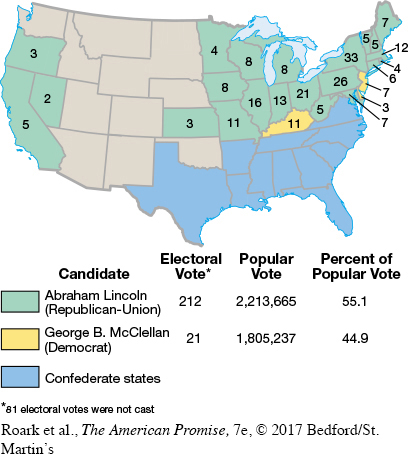The American Promise: Printed Page 433
The American Promise, Value Edition: Printed Page 396
The American Promise: A Concise History: Printed Page 453
The Election of 1864

In the summer of 1864, with Sherman temporarily checked outside Atlanta and Grant bogged down in the siege of Petersburg, the Democratic Party smelled victory in the fall elections. Lincoln himself concluded, “It seems exceedingly probable that this administration will not be re-
The Democrats were badly divided, however. Peace Democrats insisted on an armistice, while “war” Democrats supported the conflict but opposed Republican means of fighting it. The party tried to paper over the chasm by nominating a war candidate, General George McClellan, but adopting a peace platform that demanded that “immediate efforts be made for a cessation of hostilities.” Republicans denounced the peace plank as a cut-
The American Promise: Printed Page 433
The American Promise, Value Edition: Printed Page 396
The American Promise: A Concise History: Printed Page 453
Page 436The capture of Atlanta in September turned the political tide in favor of the Republicans. Lincoln received 55 percent of the popular vote, but his electoral margin was a whopping 212 to McClellan’s 21 (Map 15.4). Lincoln’s party won a resounding victory, one that gave him a mandate to continue the war until slavery and the Confederacy were dead.
Major Battles of the Civil War, 1863–1865
| May 1– |
Battle of Chancellorsville |
| July 1– |
Battle of Gettysburg |
| July 4, 1863 | Fall of Vicksburg |
| September 16– |
Battle of Chickamauga |
| November 23– |
Battle of Chattanooga |
| May 5– |
Battle of the Wilderness |
| May 7– |
Battle of Spotsylvania Court House |
| June 3, 1864 | Battle of Cold Harbor |
| June 27, 1864 | Battle of Kennesaw Mountain |
| September 2, 1864 | Fall of Atlanta |
| November– |
Sheridan sacks Shenandoah Valley Sherman’s March to the Sea |
| December 15– |
Battle of Nashville |
| December 22, 1864 | Fall of Savannah |
| April 2– |
Fall of Petersburg and Richmond |
| April 9, 1865 | Lee surrenders at Appomattox Court House |